One of the earliest reviews we did here at The Martialist was of the Canemasters self-defense cane and accompanying video program (which, at the time, was a VHS tape). My interest in cane fighting techniques stems from an accident many years ago in which, while sparring outside on a flat riverbed made of broken rock, I shoved my foot in a hole and smashed my ankle against a sharp outcropping. Had I not been wearing a heavy boot, my ankle would have been shattered. As it was, the contusion I suffered caused my ankle to swell like a grapefruit. The Urgent Care doctor was certain I had broken it until the x-rays said otherwise.
I hobbled around on my Canemasters cane for several weeks, trying not to let the injury slow me down. I was, in fact, on the phone to my teacher the very next day, asking when we could practice cane defense methods. An able-bodied person would be no less served by learning the basics of the defensive cane. Canes are legal to own, legal to carry, and — depending on the style you tote — very low-profile. When you carry a cane, you are essentially carrying a fighting stick (or escrima) already deployed for action. What’s more, your fighting stick has a hook on the end for grabbing.
For purposes of cane defense, I recommend against canes that have no crook. These are more likely to be construed as clubs, particularly if you don’t need the cane to walk. (If, on the other hand, you do need the assistance of a cane for day-to-day locomotion, you can get away with a lot more in terms of the style of walking stick you carry.) The crook also provides you with great versatility for tripping and steering your opponent.
From the outset, I should explain that the method I’m imparting here is not drawn from any specific program — not Canemasters, not Ted Truscott’s Raising Canes, and not Charles Davis‘ program (one of our sponsors). The techniques described herein are purely those that I personally find most useful and practical. Standard disclaimers apply, your mileage may vary, blah blah blah. Anything you like probably came from one of those programs; anything you don’t like can be blamed solely on me.
I recommend wielding the cane as an overlong escrima with a hook on the end. It need be no more complicated than that. What that means is you’ll use the stick for striking and thrusting, for blocking, and for a limited amount of grabbing and steering. You won’t be using it as a tool of leverage for complicated pressure point and joint lock techniques, and you absolutely will not use it for flailing, swinging, uncontrolled whirling of the cane. The latter are often demonstrated by would-be cane exponents who don’t understand the weapon and don’t know what they’re doing.
Blocking
The first thing you can do with an impact tool like the cane is block a strike or an incoming weapon. The most practical way to do this is with two hands. Gripping the cane toward the ends, strike out as you block to whichever angle — up, down, left, and right — and be prepared to retract the cane and move or zone as you block. In the case of upper and lower blocks, you may choose to drive forward and jam the incoming attack as you block, or you may need to bow your body to avoid a low strike as you intercept it with your downward blocking motion.
While it’s not as easy or as effective to do, you can also block with one hand, bracing the crook against your arm and using the cane to bolster a forearm block. This means your arms is doing more of the work and the cane is doing less of the work, which is why I’m not as fond of this method. But you can do it, and if you’ve got another weapon in your opposite hand this one-hand block may be all that you can manage.
Remember that every block with the cane is essentially a strike. You must “hit” outward as you block for your block to have sufficient force. Blocking aggressively while driving forward is simply good fighting principle, too.
Striking and Thrusting
There are several different ways you can accomplish striking with the cane. The most obvious is that you can thrust with the tip, and if you do, I would recommend holding the cane in both hands to get maximum force behind it. Wielding the cane in this way — as if it were a larger staff — also gives you a great deal of control. From a tip thrust like this, you can reverse the cane and strike or hook and steer from the crook end.
Less obvious, but more powerful, is to strike with the crook of the cane. This is not a thrust, but a swinging, slashing movement that uses the rounded portion of the crook as the striking surface. The subtle difference in balance makes the crook end a very natural striking point. You can develop tremendous power with this type of swing.
There are those who object to striking with the crook on the grounds that an opponent could use the crook for leverage to grab and hold your weapon. This is only an issue if you’re very slow, very weak, and prone to posing with your weapon on the target (rather than withdrawing it) when you strike. There is no more danger that an opponet will grab the crook of a cane than that he might grab, say, the swinging end of a pair of nunchaku. Wielded properly, the striking cane simply moves too fast for the average person to grab like that.
This is not to say that a grab can’t and won’t happen. If it does, rejoice. The best thing an opponent can do is tie up one or both of his hands by trying to grab for your weapon. The cane can’t hurt you if it’s not under his full control, but if he’s tied up with it, take advantage of that fact. Grip the cane with just one fist and hit him with your free hand.
With two hands on the cane, you can combine techniques by first thrusting, then reversing the cane and striking with the crook, then thrusting again as you reverse on the rebound of your strike. Mixing up thrusts and strikes produces a technique flow, both in training and in application. Remember always to strike for the closest target with the most logical technique for that target. Don’t try to force a touch that just isn’t likely to work.
Hooking
The primary advantage of the crooked cane for self-defense (apart from the fact that it can be carried in plain sight) is the leverage provided by the crook. As follow-through from a strike, or as defensive techniques in and of themselves, hooking maneuvers can put your opponent off balance. The sharper crook points of “fighting” canes make such a technique even more effective, because if you miss getting a good “grab” with the crook (the point of the crook is pressing against a body part rather than hooked around it), the pressure from the tip will still pull that body part to you with considerable force (and even pain).
Hooking techniques are techniques of opportunity. You don’t wade into a self-defense scenario expecting to use them. Instead, you use them when some portion of your opponent happens to come into range and you notice this. You can hook the ankle or lower leg, the results of which should be obvious. You can also hook the shoulders, “steering” your opponent to one side or the other. You would do this as a means of very quickly repositioning yourself (or, more accurately, repositioning the opponent relative to you). The movement has to be fast because otherwise the two of you will find yourself fighting in place, locked in a battle of muscle with the cane trapped between you.
What you will not do in realistic cane defense is apply any sort of complicated joint lock or leverage, involving either the crook or the shaft of the cane. These techniques are simply too complicated to work in practical self-defense. They generally take too long to apply, meaning that while you’re trying to get them in and apply pressure, the opponent has time to fight you for possession of the cane pressed against some part of his body.
Previously I have discouraged the reader from attempting pressure-point and joint-lock techniques with the yawara or pocket stick. I similarly discourage any sort of joint lock method with the cane because there is too much risk for too little possibility of success.
Seek Training
The basic concepts described here are enough to get you started, but to learn effective defense with the cane, you’ve got to get training with the weapon. Kali/Arnis and other Filipino Martial Arts (FMAs) will help you with the basics of striking and body positioning with sticks and similar weapons (including long blades), so that’s an obvious place to start. There are also several instructional programs on the market (whose offerings include seminars, DVDs, and supplemental materials). Among those The Martialist endorses are the programs of Charles Davis, Ted Truscott, and Canemasters. We may not be in complete agreement with the curricula of these providers, but their overall programs are sound and we recommend each of them.
Too many people — who have in their heads little more than the vague idea that the cane can be a weapon — pick up a drugstore cane and take to the Internet brimming over with faulty or ill-conceived “self-defense” information. The study of the cane as weapon requires more practical knowledge than that, and only in-person training can truly provide that knowledge. Remember, please, that all supplemental and in-home training materials must be secondary to actual martial arts instruction in the use of sticks and staffs as weaponry.
To carry a cane as a weapon of self-defense is to have with you a remarkably useful tool. Yes, it is a weapon… but it is also a means of keeping your balance in difficult terrain or when suffering from back pain or joint problems. The cane extends your reach, gives you a makeshift handle, and can be an emergency lever. It is stronger than your flesh and it does not feel pain. It can be everything from a fire poker to a short tent pole to a makeshift security lock for your door. The cane is therefore a versatile survival implement. Few tools so simple offer so much in return.
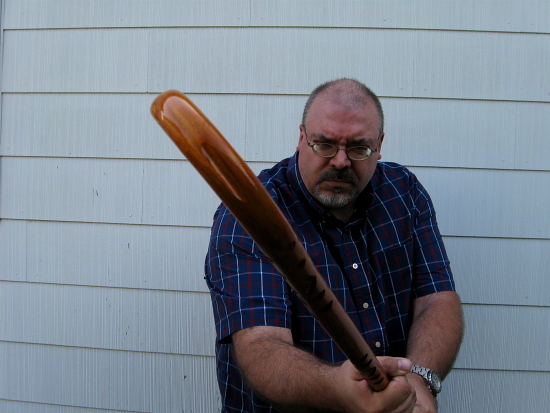
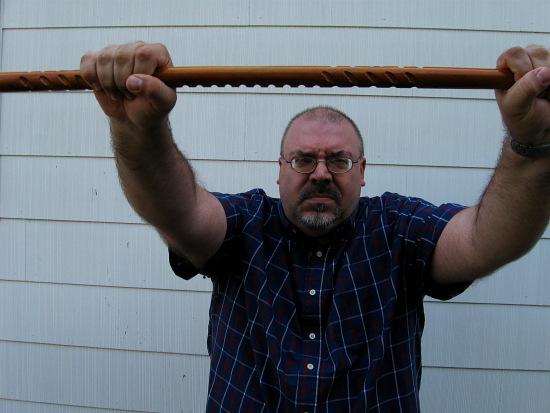
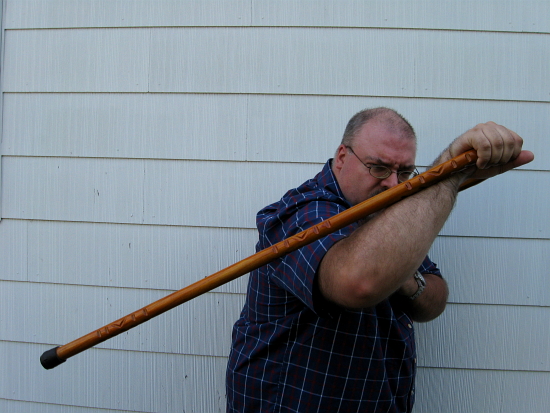
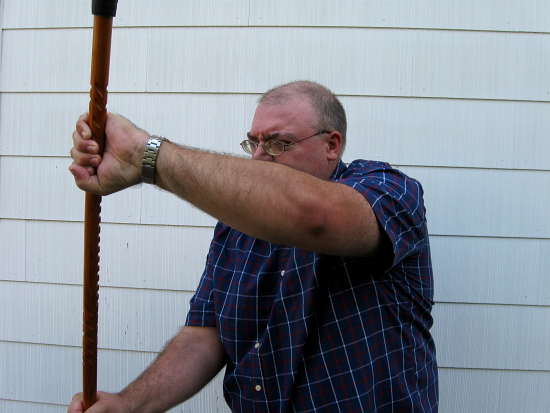
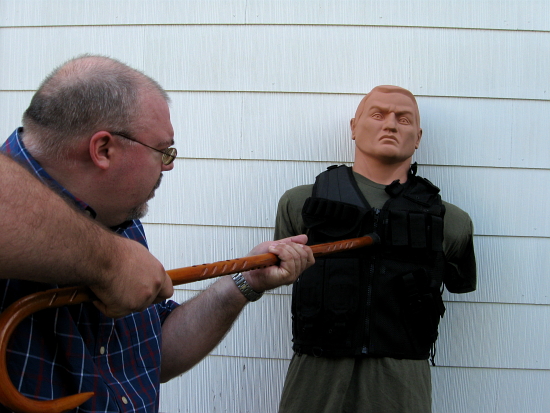
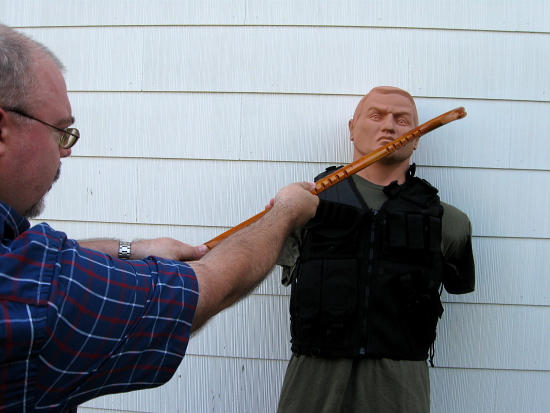
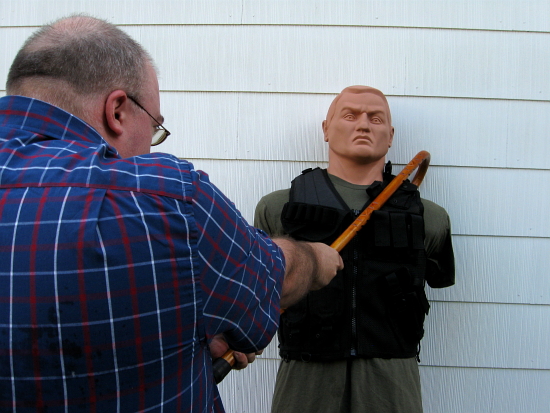
Thanks for the cane tips. I have a couple of Canemasters canes, as well as an aluminum “hiking stick” with a crook handle that I carry in the woods when walking one of my dogs. I have a very fuzzy memory of some rudimentary “Bo” training at an aikido club in college. The two-handed grip for some Bo techniques called for both palms facing away from the body, 18 inches or so apart. This grip allowed for thrusting, pool-cue style, pushing with the rear hand and guiding as the stick slipped through the front hand. If the target grabbed the end of the stick, there was enough leverage in the two-handed grip to do some interesting things to the grabber, using his grip to his distinct disadvantage. I’m an utter amateur, but it seems like the cane could be gripped the same way, especially in close quarters, and some of the same Bo techniques used. Just a musing from a total greenie. Thanks again, Phil.
hey Phil, whats your opinion of the Cold Steel line of canes? had a chance to check them out yet?
I had a City Stick at one time that was very well made. I’ve not yet handled any of the white waxwood canes they sold before (I don’t know if they still do) or the latest generation of sticks and canes they sell.
I dont understand your reluctance to strike with the cane. It seems to me that a controled two hand strike to a forearm that is holding a knife or some other weapon would be a good thing to do if opportunity arrises. Just another “trick in the bag” to use if needed.
I’m not sure why or how you read some sort of “reluctance to strike with the cane” into what I’ve posted here. That’s not accurate.
What do people who know do about cane tips?
I have been practicing pokes agains a large boat bumper and it seems like there is a significant diff between pokes with a rubber-tipped cane and the same cane with no tip.
But without a tip there seem to be issues with traction (i.e. the cane slipping on, say, linolium or smooth tile) and just plain wear on surfaces like concrete.
Is there a middle way: something that gives traction and wear resistance while preserving the concentration of force that a tipless cane has?
I use a cane for walking, but it has a Tee handle. it is more comfortable for me to use. can it be used with the same method as a cane with a crook handle ?
Hi Phill,
It’s all good,,,I am a 68 year old 6th degree black belt in Combat Jujitsu 52 years of experience, and taught improvised weapons including the cane. However 2 years ago my hips went. I get the left one done in 30 day and the right one after that.
What I found is I need the cane for balance. Once I swing my speed, balance and power are cut in half. Needless to say that is not a good thing. Suddenly I am eating my own words from things I taught. All is good if you don’t need a cane but things change quickly if you do.
When I recover I am only going to teach what the average person with a cane can do. Block, thrust block, thrust ect. Now I know swings are not possible. Can you suggest a 12, 10, 8 or even 6 technique course for people who need the cane.
I have a heavy Oak version fron Cane Masters (6 yars ago) too heavy to actually use unless you don’t need a cane. Right now I just practice thrusting to hit EXACTLY whare I want.
Best of luck.
Paul
Hi Phil,
In the past I read your articles with great interest. Over time my interests have shifted but with the prospects of hordes of “newcomers” arriving, and me being handicapped in the legs, I am again interested in self defense. This time with a cane, which I use daily. I’m looking at different canes and will pursue training. I moved to a small town with no cane training schools so videos will be my trainer.
Thank you for your website, I’m so glad I ran across it again.
Best,
Karen in Suisun, Ca